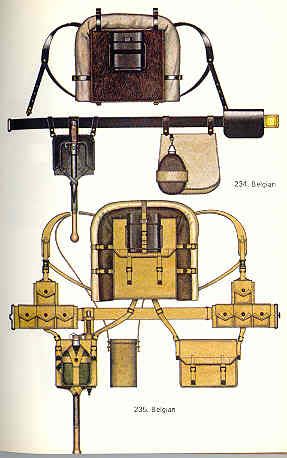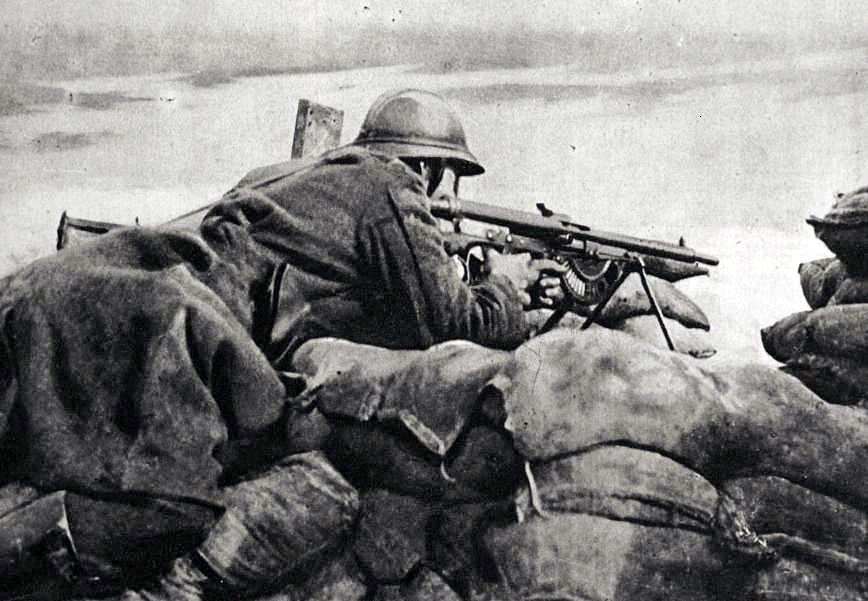From the Yser to the Scheldt II

The first khaki greatcoats were issued in December of 1915. These could be either single or double-breasted, and could feature just simple flap pockets or the addition of vertical slash pockets above the flapped side pockets. All of the greatcoats had drab-painted Belgian Lion buttons and broad shoulder straps that were fastened on either end with the same buttons. As with the tunic, the shoulder straps could be piped in the branch color, but this was likely uncommon. Rank insignia remained the same for NCOs, and was worn on the sleeves of the tunic and the greatcoat.
The first Adrian helmets were issued to Belgian troops in November of 1915. These first helmets were rushed to the Belgians from their French allies, and while they bore the lion’s head insignia, they had been painted Horizon Blue. Later helmets were all painted khaki. The last two years of the war saw a new standardized service cap as well. This was the khaki bonnet de police, which featured a tassel and branch piping. The soft cap would have likely still been seen through much of 1916, and possibly into early 1917, but the new tasseled cap would have been the predominant by the close of the war.
With the new system of supply in full swing by the close of 1915, the Belgian Army began to regain some degree of uniformity in its appearance. There could be minor differences between tunics and/or caps, but the color was at least beginning to be the same across platoons, companies, regiments and divisions. The typical Belgian boot in 1916 still resembled its French counterpart, but it would have increasingly been left un-blackened, and thus appeared in varying shades of brown. Some Belgian uniforms, including the boots, came to closely resemble the American uniform, especially after 1917, as the Americans became another primary supplier for the Belgian forces. These uniforms were also modified to include Belgian buttons and collar patches.


The recreated Jas in the above photo is wearing the complete M1915 uniform, including the Khaki greatcoat, tunic, and straight-legged trousers. He also has the M1915 Adrian Helmet (painted khaki) and helmet cover, brown M1891/1915 anklets and brown boots. As discussed further below, his accoutrements are a mix of the Mills M1915 pattern web equipment and pre-war Belgian equipment, including the canteen, bread bag (which were still being issued but in a lighter color), and the mess tin, now being painted with a mustard color. Though barely visible, this soldat also wears the M1915 ‘Argentine’ style bandoleer for his ammo pouches. Finally, he is equipped with both a French M2 gas mask and a later model ARS17 mask, which he wears in the canister slung over his shoulder.
According to a directive from January 1917, the new basic uniform consisted of the following:
- uniform - khaki greatcoat, jacket, and trousers; M1915 Adrian helmet painted in khaki, and khaki bonnet de police; M1891/15 gaiters in brown leather or khaki puttees, and boots (various makes and models, but mostly left brown in color)
- off-duty and work uniform - pair of off-duty clogs, and work uniform consisting of jacket and trousers made from blue linen
- knit and under garments - suspenders, faux-col, wool socks, cotton or wool-flannel shirt, under drawers and waist belt/wrap; wool sweater, mittens and cap or balaclava
- other small items - tin cup, handkerchief, sewing kit w/ scissors, comb, two towels, and rifle, shoe, and clothes brushes; plaque d'identite
- accoutrements - mess tin w/ utensils, canteen w/strap, bread bag or haversack, ammunition pouches w/ belt and/or straps (either the Gomez, Mills, or French M1888 pattern) bayonet and frog, e-tool w/ carrier, wool blanket, canvas shelter half or rain cape, and rucksack or knapsack (again, of varying makes and models)
As previously mentioned, there were concerted efforts to keep the Belgian Mauser as the primary rifle for the army. It is likely, however, that a small number units still carried French or British rifles in 1916-1917 out of necessity. French and British machine guns would have been the norm in the Belgian line, with the French Chauchat being prominent. In addition to the Browning pistols used in the pre-war army, the 1911 Colt .45 also became quite common in the Belgian ranks during the latter part of the war.

The one area in which the Belgian army struggled to gain some degree of uniformity was in its equipment and accoutrements. Accoutrements remained somewhat varied for much of the war. The M1896 belt and ammunition pouch remained in service long after the rest of the M1896 set was abandoned. For much of 1915-1916, the Belgian equipment would have been a mix of the M1896 accoutrements, along with French canteens, bread bags, knapsacks, and tent/shelter halves, and some British accoutrements, such as the Sam Browne equipment. Another expedient seen in 1915-1916 was the adoption of the so-called Mauser ‘Argentine’ or 'Gomez' pouches.
The color of the equipment was also changing during this time. As with their boots, the Belgians were increasingly being issued with brown rather than black accoutrements. This included the M1891 leggings, which were still being manufactured, albeit in numbers insufficient to make it a universal item. For this reason, it would have still been common to see puttees being worn on the line, primarily made from the same khaki material as the uniform.
There was some effort made to bring about a standard set of accoutrements. From 1917 the Belgian Army began to receive the British-style but American-manufactured Mills M1915 pattern equipment. Like the M1915 uniform, the M1915 set was very similar to the British P1908 web gear. The major differences were the single top pouch on either side and the American-style belt clasp. The photo below, from World War One Infantry in Color, offers a comparison of the Mills 1915 set with the earlier M1896 accoutrement set:

Notice that the Belgian Mess Tin was still being issued, though it would have more than likely been painted in a mustard color rather than in black, especially by the time the Mills sets were issued. Also notice that the British-style knapsack and haversack have replaced the Belgian pre-war and emergency knapsacks and bread bags. The photo also shows the addition of a shelter half, likely of French issue, a French ARS anti-gas protection canister, and British-style canteen, which attached either to the belt or to the e-tool as shown. The Mills equipment was supposed to include the Belgian Lion on all of its button snaps.
The Mills equipment was not issued all at once. The canvas knapsack appeared first in 1916, and would have been seen alongside the French-inspired canvas knapsacks already in use. The ammunition belt and pouches did not arrive until early 1918. Even then, the Mills pattern equipment did not entirely replace the earlier, mixed accoutrements. As mentioned earlier, the Belgian bread bag continued to be issued, albeit in a lighter shade, and the Belgian canteen and ‘Argentine’ pouches did as well. The top photo on the previous page, probably dated sometime in 1917 or early 1918, shows mostly Argentine pouches, but at least one individual is wearing the Mills 1915 belt and pouches. Due to the extremely damp conditions on the Yser front, the Belgian Army also received rubber boots, jackets, and thigh-high waders, largely manufactured in the United States. These first appeared in October of 1915. There were never enough for wide dispersal however, so they were often reserved for reconnaissance units and patrols. The khaki uniform served the Belgian Army well between 1916 and 1918. It would remain the base uniform for the Belgian forces, with only minor alterations, through the start of the Second World War.

Belgian soldier in late-war uniform, manning a French Chauchat machine gun.